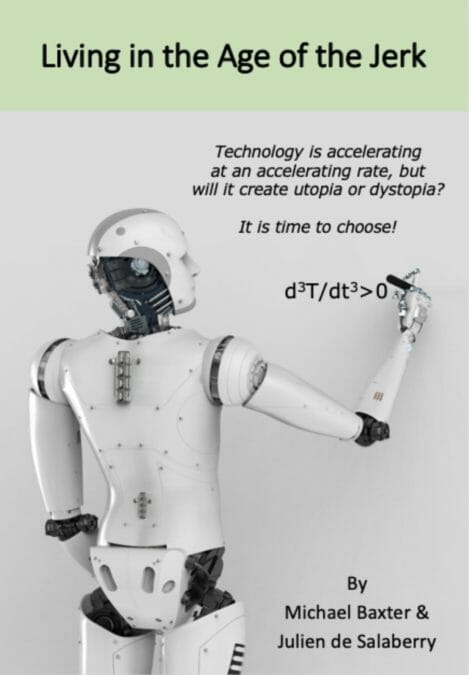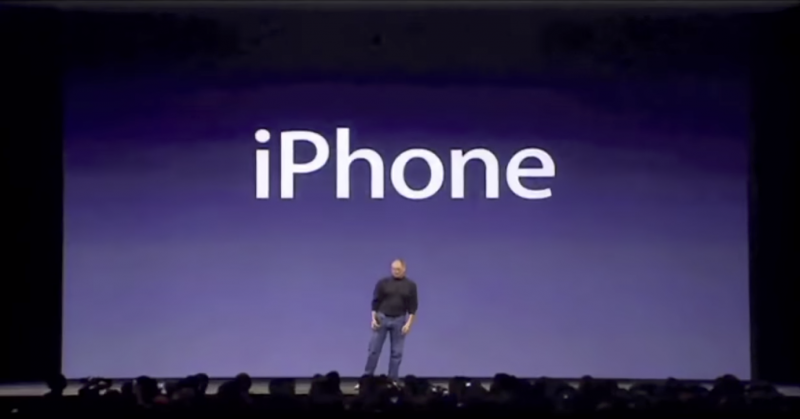A Look Back, a Giant Leap Forward in Expected High Tech Events
Michael Baxter, the former editor of Information Age, created a list of key technology events for his book, ranging from the first computer to predictions of future events up to 2054.
Informationage.com let Baxter excerpt passages from the book he’d written with co-author Julien de Salaberry, called “Living in the Age of the Jerk.” The book’s premise is that humans must keep control of technology before it creates a dystopia.
The past memorable moments come as no surprise, but the predictions for the future are disquieting:
PAST
1832: Charles Babbage invents the first Computer.
1904: John Ambrose Fleming invents the vacuum tube.
1936-1938: Konrad Zuse creates the first electro-mechanical binary programmable computer.
1936: Alan Turing proposes what has become known as the Turing Machine.
1940: Alan Turing’s Bombe is able to decrypt the enigma code.
1943: Thomas Watson, president of IBM, states: “I think there is a world market for maybe five computers.”
1947: John Bardeen and Walter Brattain, with support from colleague William Shockley, demonstrate the transistor at Bell Laboratories in Murray Hill, New Jersey.
1949: Popular Mechanics states: “Where a calculator like ENIAC today is equipped with 18,000 vacuum tubes and weighs 30 tons, computers in the future may have only 1000 vacuum tubes and perhaps weigh only 1½ tons.”
1959: Richard Feynman gives a lecture with the title: “There’s plenty of room at the bottom.” Although Feynman’s role in its development may be exaggerated, this is considered by many to be the point when the concept of nanotechnology was first conceived.
1965: Gordon Moore, who later went on to co-found Intel, states that the number of the number of transistors on a computer chip doubles roughly every two years, and so Moore’s Law was defined.
1966: K.C. Kao & G.A. Hockham publish “Dielectric-fibre surface waveguides for optical frequencies,” proposing optical fiber communication
1969: ARPANET funds the first packet-switched message between two computers marking the beginning of the internet.
1976: Apple 1 released.
1980: John Bannister Goodenough invents the cobalt-oxide cathode making the lithium-ion battery that now sits in smart phones and electric cars, possible.
1985: Akira Yoshino, enabled industrial-scale production of the lithium-ion battery, representing the birth of the current lithium-ion battery.
1981: IBM invents the PC.
1889: Sir Tim Berners Lee at CERN proposes HTML, the standard that made the World Wide Web possible.
1997: IBM’s Deep Blue defeats Gary Kasparov at chess.
2001: The human genome is finally sequenced.
2004: Prof Andre Geim and Prof Kostya Novoselo from Manchester University isolate graphene.
2005: Boyden ES, et al. Nat Neurosci publish a paper showing how a protein in a certain type of algae reacts to light. See above.
2007: Apple releases the iPhone.
2011: IBM’s Watson defeats two Jeopardy champions.
2012: Jennifer Doudna, and Emmanuelle Charpentier from the University of California, Berkeley and Umeå University in Umeå, Sweden, publish a paper showing how CRISPR/Cas 9 is used by bacteria to protect themselves from viruses by editing their own DNA.
2017: Google subsidiary DeepMind’s software AlphaGo defeats world’s best player at Chinese game of Go, something previously considered impossible for a computer.
FUTURE PREDICTIONS
2022: AI is harnessed in the battle against fake news. This will be the start of a 10-year process.
2023: Evidence shows that autonomous cars are marginally safer than cars driven by people.
2024: Highly accurate real-time voice translation devices linking earphones via the cloud to AI translation tools become available, meaning that we can talk to anyone on earth. A public debate ensues – why do we need to learn more than one language if translation tools are so accurate?
2024: Quantum computers begin to emerge as an alternative to conventional computers, for certain tasks and accessed via the cloud. Moore’s Law for Quantum Computers, Rose’s Law applies, to certain types of quantum computers, meaning that the number of qubits in scalable quantum computing architecture double every six to 12 months.
2025: The cost of renewable energy and energy storage which had been falling for decades reaches a tipping point, when the economic benefits of renewables over fossil fuels becomes overwhelming. But will this be enough to win the war against climate change? Scientists will say we need to do more. As the evidence for climate change becomes plain for all to see, there will be a backlash against companies and politicians who were seen as denying climate change or who deliberately tried to confuse public understanding.
2027: Projected date for automated truck drivers.
2030: Autonomous cars become so much safer than conventional cars that nearly all new cars are exclusively autonomous. The cost of insuring cars driven by humans escalates. Rules are introduced to heavily regulate traditional cars, to protect innocent passengers in autonomous cars from human drivers.

GUESSES OF DISTANT FUTURE TECH
2031: The age of the sharing car economy dawns. It will be called TaaS — transport as a service. With this development, the psychology of driving changes. We will no longer see our car as ‘our pride and joy’ or even an appendage, in which male drivers see their automobile as an extension of their manhood, as a method to attract potential mates, because cars will no longer belong to us. As a result, cars will become more functional, and there will be less variety. Since the average car is parked for around 95 per cent of the time, the emergence of the TaaS model will mean consumer demand could be met with between 5 and 20 per cent less cars. This will have a devastating effect on the auto-industry.
2031: Emerging markets, for several reasons, but primarily because they will not be hampered by technology legacy, unlike in the West, will begin to emerge as the new economic powerhouses.
2031: CRISPR/cas 9 products become commonly available. The DNA of certain food products will be modified as will the DNA of disease carrying animals such as mosquitos and then in time, human DNA will be modified, at first by treating disease, later to augment us, even to reverse ageing. The resulting ethical implications will be hotly debated.
2032: The fake news battle reaches new heights as augmented reality products whisper into our ear, advising us if information we have just heard or read may in fact be fake, or misleading. Although the intention behind this is well meaning, there will be a massive public backlash and claims of state sponsored indoctrination. Some press, which will fall victim to the fake news apps will be among the more vociferous critics.
2032 – 2040: Augmented reality begins to transform the way we communicate over distance. Green screens become ubiquitous in restaurants, meeting rooms, offices and even in the bedroom, as we communicate, enjoy simulation of face-face interaction, we can work from home or a local office even though it will feel as if we are working with others in an office many miles away, maybe even thousands of miles away. We will eventually be able to make love, or an approximation, at a distance.
2034: The era of Quantum supremacy. For certain applications, such as studying molecules or protein founding, quantum computers will be thousands of times more powerful than conventional computers. But they won’t be able to do everything that conventional computers can do. Instead we will see convergence: quantum computer, plus conventional computer, and hopefully, plus human proves to be a formidable combination.
2035: Neuro computing reaches a level such that technology is finally applied to augment our own cognitive abilities. Interfaces between brains and computers will emerge at around this time, and before the end of this decade, it will be possible to control our brain augmented devices by thought alone.
2035: Climate change will be reaching a level of such threat that governments will realize we are reaching a do-or-die moment, that only global cooperation can save us from ourselves, and only by building carbon capture projects on a massive scale can we stop and possibly reverse some of the disastrous effects. Just as technology caused the climate change crisis in the first place, it will be required to come up with a fix. Carbon capture becomes essential.
2035: Lab grown meat (from stem cells) competitive in price with conventional meat.
2040: Conventional meat becomes a niche product as lab grown meat proves superior, environmentally better and cheaper.
2044: Quantum computers become one million to a trillion times more powerful than in 2024.
2045: Revolution in battle against climate change — advances in cultured meat will be such that millions of acres of land currently used for grazing animals will be freed up. Billion of tress will be planted on this land and the option to reverse climate change then becomes viable, but is this breakthrough in time?
2049: Projected date for AI writing a bestseller. “When Will AI Exceed Human Performance? Evidence from AI Experts”
2054: Projected date for Robot surgeons.
Baxter and his co-author plan to release their book in early 2020.








Leave A Comment